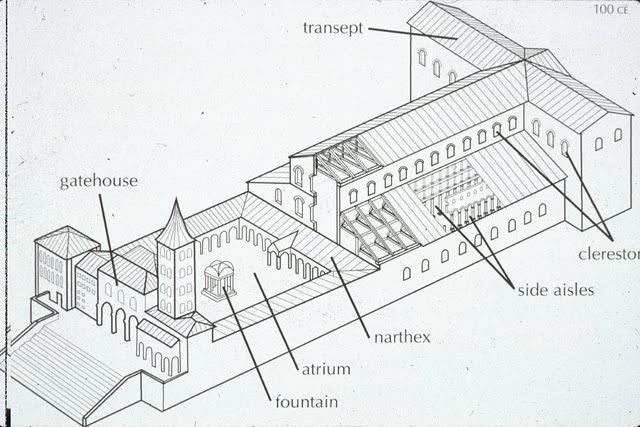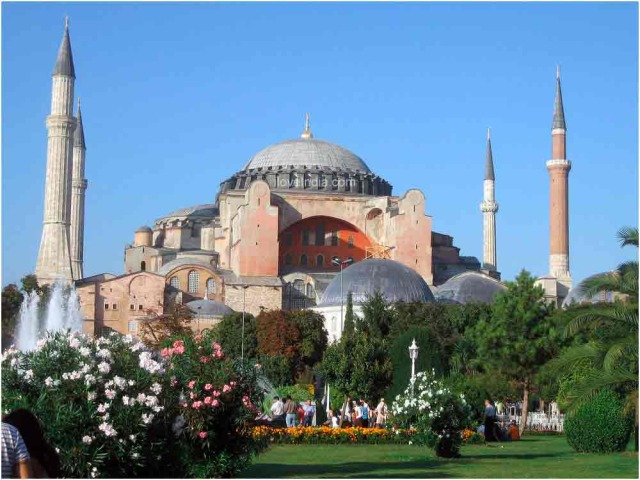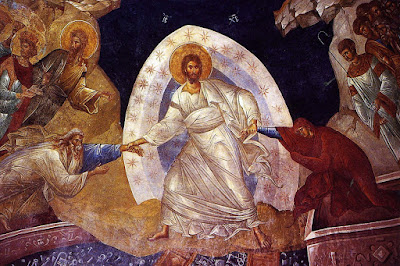Cards In This Set
| Front | Back |
 What is this? |
Wall with Torah Niche.
Origin: Syria Period: Jewish Medium: Tempera on Plaster Additional info: From inside a synagogue built within a private home. Scenes from Jewish history cover the walls. The story of Moses unfolds in a continuous narrative around the room, employing the Roman tradition of epic historical representation. The frontal poses, strong outlines, and flat colors are pictorial devices associated with Near Eastern Art. |
 What is this? |
Good Shepherd.
Origin: Turkey Period: Early Christian Medium: Marble Additional info: Was found with sculptures portraying the life of Jonah, so likely commissioned by a Christian. |
 Memorize these parts. |
 Reconstruction of the old St. Peter's Basilica. Origin: Rome Period: Early Christian Additional info: Project undertaken by Constantine, thought to be for his mother. Timber building, eventually delapidated / torn down. Could accomodate 11,000 people. *I THINK WE CAN ASSUME THE ELEMENTS OF ARCHITECTURE WILL BE ON THE EXAM* |
|
What is this? |
Santa Sabina.
Origin: Rome Period: Early Christian Additional info: Built in brick and unusually retains its windows. On many other churches they were bricked in. Outside is plain, the inside is more impressive. Interior constructed by Peter of Illyria. Basic elements of basilica church are visible: nave lit by clerestory, side aisles that end in a rounded apse. |
 Memorize these parts. |
 Central Plan Churches. *KNOW THESE DIAGRAMS* (p. 174) |
 Memorize these parts. |
 Basilica Plan Churches. *KNOW THESE DIAGRAMS* (p. 174) |
 What is this? |
 Hagia Sophia. Origin: Constantinople Period: Byzantine Patron: Justinian Additional info: Designed by Anthemius of Tralles and Isidorus of Miletus. Anthemius was a specialist in geometry and optics and Isidorus was a specialist in physics who had studied vaulted construction. Innovative hybrid of longitudinal and central planning. Dominated by hovering form of its gigantic dome. Dome rests on pendentives (triangular curving wall sections) that connect base to supporting piers. |
 What is this? |
San Vitale.
Origin: Ravenna Period: Byzantine Patron: Ecclesius, local Bishop, but completed only after Justinian's conquest of Ravenna. Additional info: Built by Justinian. Reclaiming lost territories from Barbarians, though he was never actually present. Dedicated to Saint Vitalis. Its design is basically a dome-covered octagon surrounded by eight excedrae, or semi-circular niches, one of which is extended through the aisle to form the santuary. |
 What is this? |
Justinian and attendants.
Origin: Ravenna Period: Byzantine Patron: Ecclesius, local Bishop, but completed only after Justinian's conquest of Ravenna. Additional info: Justinian's head surrounded by halo, wearing huge jeweled crown and purple cloak. Carries a large golden paten that he is donating to San Vitale. Bishop Maximianus (head of Church in the West) at his left holding a jeweled cross. 6 clergymen. 6 soldiers. 12 apostles. Spiritual hierarchy. |
 What is this? |
Virgin and Child with Saints and Angels.
Origin: Egypt Period: Byzantine Additional info: Important function not only as an educational tool, but also in the removal of earthly distractions from the viewer's mind. Instruction about hierarchy within Church- Theodore and George on the sides, flat gold plates behind heads indicate holiness. Angels at the top staring at heavens. Hand of God. Mary's blue robe = mourning (foreshadowing). Mary and Christ look to the side. Man does not go to God directly, but through the Church. Saints are legendary figures said to have slain dragons, symbolically triumph over Paganism. Rare because of iconoclasm. |
 What is this? |
Anastasis.
Origin: Istanbul, The Church of the Monastery of Christ in Chora Period: Byzantine Patron: Theodore Metochites Additional info: Portrays the ressurection of Christ. In the East, this was done by showing Him descending into Hell to rescue Adam and Eve and others among his devout Jewish ancestors from Satan's grip. Here, He is dressed in shimmering white silk, lunging forward. Star studded mandorla or almond shaped body halo. He has trampled down the doors of Hell, tied Satan into a helpless bundle, and shattered Hell's locks and chains which are scattered all over he ground. Dragging elderly Adam and Eve from their sarcophagi. |
 What is this? |
Chi Rho Lota Page, Book of Kells.
Origin: Scotland Period: Hiberno-Saxon Medium: Oxgall inks and pigments on vellum Additional info: Very expensive to produce, est. 150 calves slaughtered for this book. Manuscripts were done in monasteries in a scriptorium. It was the work of God copying the word of God. Often developed abbreviations, made a lot of mistakes resulting in incorrect copies sent off as templates. The large Greek letters (chi ro lota or XPI) abbreviate Christi, starting the phrase "Christi autem generatio" Ingeneratio - the beginning of the New Testament - Book of Matthew. Cat and mice represent strife of the world, a necessity for the coming of Christ. |
 What is this? |
Palace Chapel of Charlemagne (Palatine Chapel).
Origin: Germany Period: Carolingian Additional info: Charlemagne's private chapel, for his family and where his court would gather. After his death, it was his mausoleum. Draws specifically on San Vitale, but has a much darker and heavy effect. Introduction of westwork, or monumental entrance block. |
 What is this? |
Matthew the Evangelist, Ebbo Gospels.
Origin: France Period: Carolingian Patron: Archbishop Ebbo of Reims Medium: Ink and colours on vellum. Additional info: Depicted like an average individual, not really a naturalistic landscape. Byzantine reverse perspective. Odd, spindly hands at unusual angle. Abstraction of proportions. Emotional response due to robes, disheveled hair, worried brows, consumed by work. Erratic emotion and agitation. Charged with energy. |
 What is this? |
Crucifixion with Angels, Lindau Gospels Cover.
Origin: Germany Period: Carolingian Patron: Emperor Charles the Bald. Medium: Gold, pearls, sapphires, garnets, emeralds. Additional info: Combines jewels and pearls with sculpture in gold. The Crucifixion formed from the gold background using repoussé. The jewels are raised on tiny feet to allow light to penetrate under them, enhancing their luster. |



